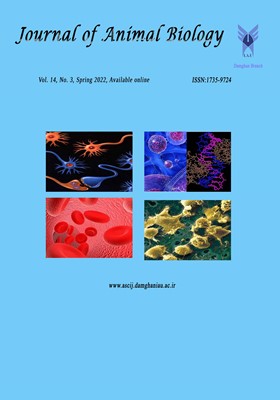The Effect of Eight Weeks of Low and High Volume HIIT Training on Lactate Response and Some Performance Indicators of Canadian Canoers
Subject Areas :
Journal of Animal Biology
Farahnaz Amir Shaghaghi
1
,
Fatemeh Karamjani
2
1 - Faculty of Physical Education, University of Tehran, Tehran, Iran
2 - Faculty of Physical Education, University of Tehran, Tehran, Iran
Received: 2021-10-05
Accepted : 2021-11-04
Published : 2022-05-22
Keywords:
Lactate,
Aerobic power,
High intensity Training,
Canadian Canoe,
Abstract :
The number of training sessions is an important factor in exercise training. Therefore, this study was aimed at investigating the effect of eight weeks of low and high volume HIIT training on lactate response and some performance indicators of Canadian canoe rowers. Sixteen female rowers invited to the Canadian Canoe National Team Camp were randomly divided into two groups: low frequency interval training and high frequency interval training. Rowing ergometer and respiratory gas analyzer were used and at the same time, physiological variables of aerobic function including maximum oxygen consumption (VO2max), minimum speed to reach maximum oxygen consumption (vVo2max) and exhaustion time (Tmax) were measured. Intense intermittent training was performed in both groups in the form of 6 one-minute rowing sessions with 100% vVo2max and with an increase of two rounds per week. The difference was that the low-frequency group practiced 3 sessions per week and the high-frequency group practiced 6 sessions per week. Exercises were performed for eight weeks. Data were analyzed by paired t-test and independent t-test. Significance between variables was considered at the level of P≤0.05. The results showed a significant difference in lactate, VO2max, vVo2max and Tmax between pre-test and post-test of both high-volume periodic training and low-volume periodic training. However, no significant difference was observed in the post-test values between the two groups in any of the variables (P≤0.05). Due to the lack of significant differences between the two groups, the combination of these two methods at different times of a Canadian canoeing season seems to be helpful in preparing athletes.
References:
Abdolmaleki, A., Samavatisharif, M. A., Nikhbakht, N. P., Amini, R. 2014. The effects of 12 weeks of low-volume high-intensity interval training and traditional continuous exercise training on adiponectin level and lipids profile in obese young men, Journal of Ilam University of Medical Sciences, 22(5): 150-159.
Berardi, G. 2013. Finding balance: fitness, training, and health for a lifetime in dance: Routledge, 12(8): 256-263.
Billat, L.V. 2001. Interval training for performance: a scientific and empirical practice. Sports Medicine, 31(1): 13-31.
Bishop, D., Edge, J., Thomas, C., Mercier, J. 2008. Effects of high-intensity training on muscle lactate transporters and postexercise recovery of muscle lactate and hydrogen ions in women. American Journal of Physiology-Regulatory, Integrative and Comparative Physiology, 295(6): R1991-R1998.
Cairns, S.P. 2006. Lactic acid and exercise performance. Sports Medicine, 36(4): 279-291.
Chavanelle, V., Boisseau, N., Otero, Y. F., Combaret, L., Dardevet, D., Montaurier, C., Sirvent, P. 2017. Effects of high-intensity interval training and moderate-intensity continuous training on glycaemic control and skeletal muscle mitochondrial function in db/db mice. Scientific Reports, 7(1): 1-10.
Denadai, B., Ortiz, M., Stella, S., Mello, M. 2003. Validade da velocidade crítica para a determinação dos efeitos do treinamento no limiar anaeróbio em corredores de endurance. Revista Portuguesa de Ciências do Desporto, 3(1): 16-23.
Fransson, D., Nielsen, T. S., Olsson, K., Christensson, T., Bradley, P. S., Fatouros, I. G., Mohr, M. 2018. Skeletal muscle and performance adaptations to high-intensity training in elite male soccer players: speed endurance runs versus small-sided game training. European Journal of Applied Physiology, 118(1): 111-121.
Gharahdaghi, N., Kordi, M. R., Gaeini, A. A. 2013. The effect of a short term soccer specific training on aerobic fitness and muscle injury of soccer players. Journal of Practical Studies of Biosciences in Sport, 1(1): 20-33.
Gibala, M.J. 2018. Interval training for cardiometabolic health: why such a HIIT? Current Sports Medicine Reports, 17(5): 148-150.
Gibala, M. J., McGee, S. L. 2008. Metabolic adaptations to short-term high-intensity interval training: a little pain for a lot of gain? Exercise and Sport Sciences Reviews, 36(2): 58-63.
Jones, A. M., Carter, H. 2000. The effect of endurance training on parameters of aerobic fitness. Sports Medicine, 29(6): 373-386.
Kenefick, R., Mattern, C., Mahood, N., Quinn, T. 2002. Physiological variables at lactate threshold under-represent cycling time-trial intensity. Journal of Sports Medicine and Physical Fitness, 42(4): 396-402.
Laursen, P.B., Jenkins, D.G. 2002. The scientific basis for high-intensity interval training. Sports Medicine, 32(1): 53-73.
Laursen, P.B., Shing, C.M., Peake, J.M., Coombes, J.S., Jenkins, D.G. 2005. Influence of high-intensity interval training on adaptations in well-trained cyclists. The Journal of Strength and Conditioning Research, 19(3): 527-533.
Mohammad Zadeh Salamat, K., Rajabi, H. 2009. Effect of rise in resistance in breathing process through a aerobic training period on time to exhaution and perceived exertion index in non athletic subjects. Physical Education and Sport Sciences Auarterly, 2(6): 53-61.
Rodas, G., Ventura, J.L., Cadefau, J. A., Cussó, R., Parra, J. 2000. A short training programme for the rapid improvement of both aerobic and anaerobic metabolism. European Journal of Applied Physiology, 82(5): 480-486.
Sperlich, B., Zinner, C., Heilemann, I., Kjendlie, P.L., Holmberg, H.C., Mester, J. 2010. High-intensity interval training improves VO 2peak, maximal lactate accumulation, time trial and competition performance in 9–11-year-old swimmers. European Journal of Applied Physiology, 110(5): 1029-1036.
Ziemann, E., Grzywacz, T., Luszczyk, M., Laskowski, R., Olek, R.A., Gibson, A.L. 2011. Aerobic and anaerobic changes with high-intensity interval training in active college-aged men. The Journal of Strength and Conditioning Research, 25(4): 1104-1112.
_||_


